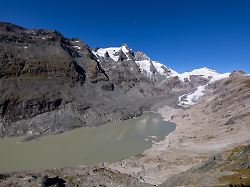Glaciers are melting extremely
The “eternal ice” in Austria will be gone in 45 years
April 5, 2024, 8:30 p.m
Listen to article
This audio version was artificially generated. More info | Send feedback
The Austrian Alpine Club has already given up on the glaciers. They are flowing away due to climate change. The club says it is too late to reverse the trend. According to the forecast, the mountains will be completely ice-free in just a few decades.
The “eternal ice” in Austria will probably be over in the foreseeable future: “In 40 to 45 years” the Alpine republic will be “largely ice-free,” said geographer Andreas Kellerer-Pirklbauer on the occasion of the publication of the current glacier report by the Austrian Alpine Association (ÖAV ).
Accordingly, 92 of 93 observed glaciers lost ice from 2022 to 2023. According to the report, two of them even receded by more than 100 meters. Austria’s largest glacier, the Pasterze in Carinthia, melted by 203.5 meters, faster than ever before. The Rettenbachferner in the Ötztal Alps in Tyrol disappeared by 127 meters.
According to the Alpine Club, the glaciers melted on average by 23.9 meters. This is the third largest glacier melt since measurements began in 1891. According to their own information, the experts determined the largest decline to date, averaging 28.7 meters, in 2021/22. Five years earlier the decline averaged 25.2 meters. This means that the three negative record values were measured within the past seven years.
Protecting the glaciers is also a safety aspect
The Alpine Club believes that a reversal of the trend is impossible. “The system is too sluggish. There should have been the first positive mass balances for years. Nothing works here anymore,” said PES expert Gerhard Karl Lieb. Climate protection measures would also come too late. On a global level, however, there is still something to be achieved.
The Alpine region explained that the Alpine region is under great pressure due to development for skiing. But the glaciers must be consistently protected. This is also a safety aspect because the ice partially supports the steep terrain. According to the World Weather Organization, glacier melt worldwide has been unprecedented since measurements began in the 1950s.
